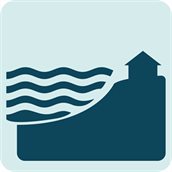Detailed assessment of coastal and fluvial floods
The detailed assessment aims to assess concentration risks, defined as the potential exposure of a single flood event to a portfolio or assets. Whereas the basic assessment focused on the depths and probabilities of all assets, a scenario-based approach allows for stress-testing extreme flood events. With a scenario-based approach, the aim is also to get a better understanding of the different flood probabilities.
Flood scenarios from breaches
The National Water and Flood Information System (LIWO) data underlying the combined scenarios used for the basic assessment, include over 5,000 scenarios for breaches of the main and regional system. Each of these scenarios are shown with their ‘true’ resolution, instead of an aggregate 25x25 metre resolution for the composite maps. Moreover, most scenarios include much more information than just flood depths, including:
- Flow velocity
- Water ascent rate
- Arrival time
- Expected damage
- Expected number of victims
- Expected number of people affected
Each of the breach locations often have different variations, including different probabilities of occurrence. Combining the inundation depths and probabilities for different breach scenarios with information on asset locations, allows to stress-test a portfolio. Such a stress-test can improve the understanding of flood probabilities compared to the composite water depth maps used in the basic assessment.

The International Monetary Fund (IMF) did a financial stability risk analysis from floods in the Netherlands using these flood scenarios. The estimated damage from each flood scenario is used to calibrate the corresponding macro-financial scenario for bank stress tests. The study highlights the need to consider various factors when assessing physical climate risks, as flood impacts on bank capital differ by scenario. Climate change increases the negative effects on banks' capital, but improved flood defences in the Netherlands can reduce some of these impacts. Additionally, there is a non-linear relationship between flood damages and banks' capital depletion, emphasising the importance of accounting for extreme scenarios.
In addition, the Central Bank of the Netherlands (DNB) performed an extensive scenario-based assessment (PDF) using the LIWO scenarios. Their assessment shows how to combine the scenario maps with financial indicators, such as loan-to-value ratios or Common Equity Tier 1 (CET1) ratios.
In addition to single breach scenarios, LIWO offers the option to combine several breach scenarios. However, it should be noted that the probability of multiple failures is lower than a single breach. Hence, it is recommended to only use the single breach scenarios.
External expertise may be required to further tailor and improve the different flood probabilities. In the next level, the tailored assessment focuses on translating water depths and probabilities into expected damages and annualised risk.

